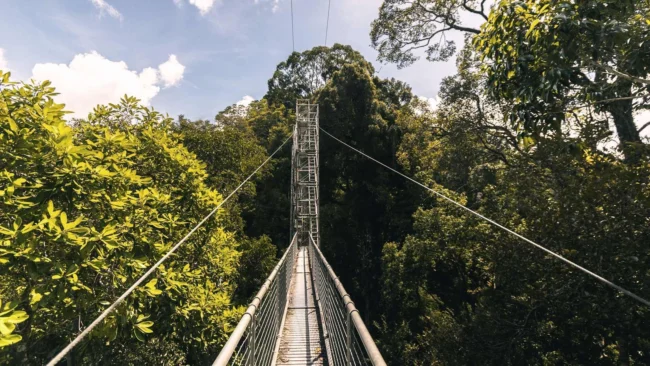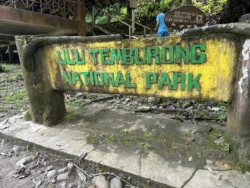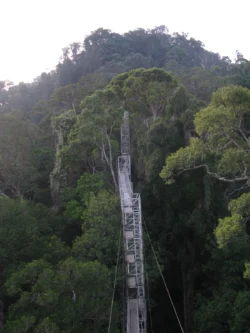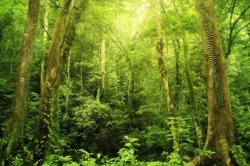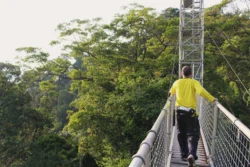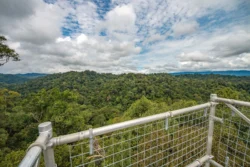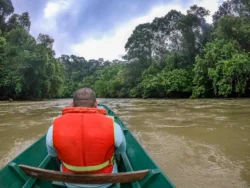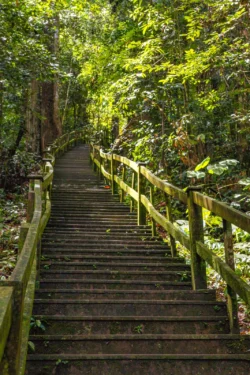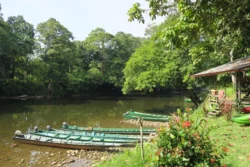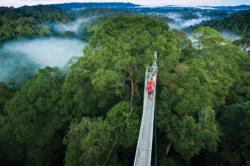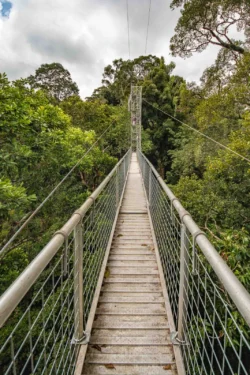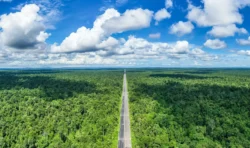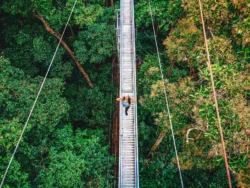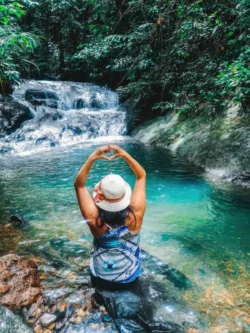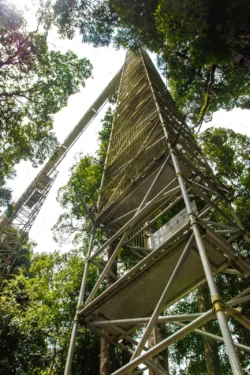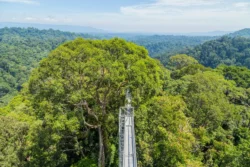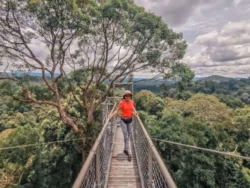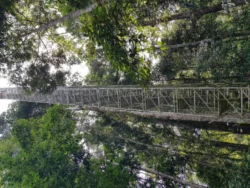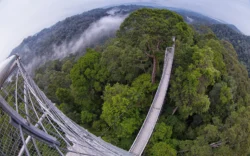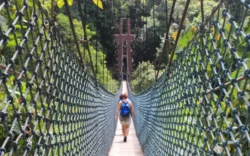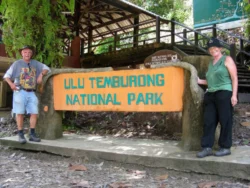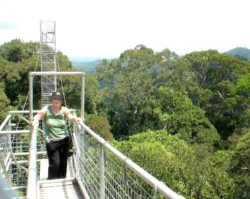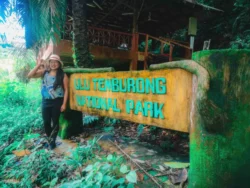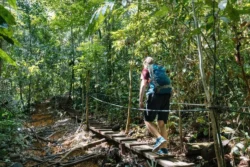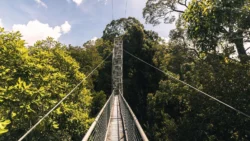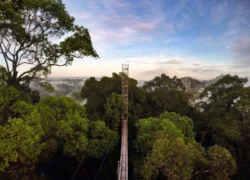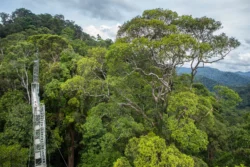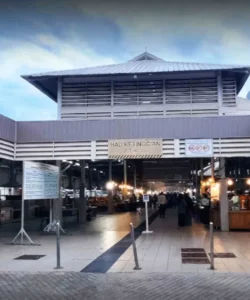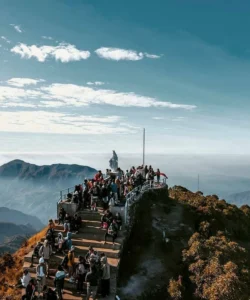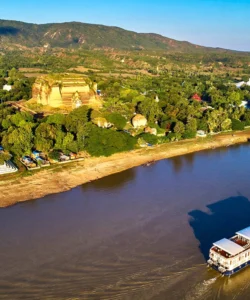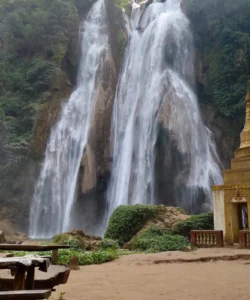Ulu Temburong National Park is Brunei Darussalam’s pristine natural jewel, a vast expanse of untouched primary rainforest located in the isolated Temburong District. It is renowned for its incredible biodiversity, its “no-impact” tourism policy, and its iconic canopy walkway, offering an unparalleled immersive experience into Borneo’s ancient jungle.
Name: Ulu Temburong National Park (Malay: Taman Negara Ulu Temburong)
Address: The park is located in the Temburong District in eastern Brunei Darussalam, which is geographically separated from the rest of the country by a sliver of Malaysian Sarawak. The park is nestled within the Batu Apoi Forest Reserve. The main gateway town in Temburong is Bangar, and the primary entry point into the park itself is via longboat at Batang Duri. The Ulu Ulu Resort (also known as Ulu Ulu National Park Resort or Kuala Belalong Rainforest Field Studies Centre – KBRFSC) is located within the park as the main accommodation and research hub.
How to Get There:
Access to Ulu Temburong National Park is highly controlled and almost exclusively via organized tour packages, ensuring minimal human impact on the pristine environment. The journey itself is a significant part of the experience.
- From Bandar Seri Begawan to Temburong District:
- By Speedboat (Traditional Method): The classic way to reach Temburong is by taking a public speedboat from Bandar Seri Begawan’s main jetty (behind the Yayasan Complex) to Bangar, the capital of Temburong. This scenic 45-minute to 1-hour journey traverses the Brunei River, crosses Brunei Bay (where you might spot the recently built Sultan Haji Omar ‘Ali Saifuddien Bridge), and then navigates mangrove-lined waterways.
- By Road (via Sultan Haji Omar ‘Ali Saifuddien Bridge): With the completion of the SHOAS Bridge in 2020, it’s now possible to drive directly from Bandar Seri Begawan to Temburong District without passing through Malaysian Sarawak. This has made access quicker and more convenient.
- From Bangar to Batang Duri: Once in Bangar, you’ll transfer to a car or minivan for a short 30-minute drive to Batang Duri. This is the embarkation point for the longboats.
- Longboat Journey into the Park: From Batang Duri, the adventure truly begins. You’ll board a traditional longboat (temuai), expertly navigated by experienced Iban boatmen, who skillfully weave through rapids, sandbars, and submerged logs on the Temburong River. This thrilling and immersive boat ride (approx. 30-45 minutes) is the only way to reach the interior of the park. Be prepared to potentially get wet or even help push the boat if water levels are low.
- Park Entry & Guides: All visits must be pre-arranged with a licensed tour operator. Upon arrival at the park headquarters or Ulu Ulu Resort, you’ll register and receive briefings. Guided activities are mandatory.
- No Self-Guided Access: This park is not open for independent, self-guided exploration. You must be part of an organized tour package.
Landscape and Architecture:
Ulu Temburong National Park’s “landscape” is a pristine, multi-layered tropical rainforest, and its “architecture” is minimal and designed for low-impact exploration.
- Ancient Primary Rainforest: The park protects approximately 550 square kilometers (212 sq mi) of untouched lowland tropical rainforest, making it one of the largest and best-preserved tracts of primary rainforest in Borneo. This deep, dense jungle is characterized by towering trees (especially Dipterocarps), a rich undergrowth of ferns, mosses, and epiphytes, and numerous winding rivers and streams.
- Hilly Terrain and River Valleys: The southern part of the park is hilly, with mountains rising to 1,800 meters (5,900 ft), while the lowlands dominate the northern slopes. The terrain is traversed by the Temburong and Belalong Rivers, forming narrow valleys and gorges.
- Canopy Walkway: The most prominent man-made “architectural” feature is the Ulu Temburong Canopy Walkway. This impressive steel-framed structure rises up to 50 meters (160 feet) above the forest floor, providing a breathtaking “bird’s-eye view” of the rainforest canopy. It consists of multiple towers connected by narrow walkways, allowing visitors to experience the upper layers of the jungle, typically inaccessible from the ground. The structure is robust, built with scaffolding-like steel components, and the climb to the top involves many steps.
- Boardwalks and Trails: An extensive network of elevated wooden boardwalks, plank walkways, and suspension bridges (some totaling 7 kilometers in length) are built above the forest floor, protecting the fragile ecosystem from human impact and allowing visitors to explore the jungle without disturbing it.
- Waterfalls and Natural Pools: Within the park, you can find small, picturesque waterfalls and natural swimming pools, offering refreshing dips after jungle treks.
- Ulu Ulu National Park Resort: The primary accommodation within the park is the Ulu Ulu Resort, an eco-friendly establishment built on stilts, designed to blend harmoniously with the environment. It offers basic but comfortable lodging and serves as a base for guided activities and research.
What Makes It Famous:
- Brunei’s “Green Jewel”: Ulu Temburong National Park is often referred to as the “Green Jewel of Brunei” due to its pristine, untouched rainforest and its immense biodiversity.
- Unspoiled Primary Rainforest: Unlike many other parts of Borneo that have suffered from deforestation for palm oil plantations, Brunei’s wealth from oil and gas has allowed it to strictly protect its rainforest, making Ulu Temburong one of the few remaining large expanses of virgin, primary rainforest in the region.
- Canopy Walkway Experience: The thrilling and iconic Canopy Walkway is a major draw, offering a unique and breathtaking perspective of the rainforest canopy from above, an experience often described as truly immersive and unforgettable.
- “No-Impact” Tourism Policy: The park’s strict protection policies, allowing only about 1% of its area to be accessible to tourists (and even that with mandatory guides and tours), emphasize sustainable, low-impact ecotourism. The rest of the park is reserved primarily for scientific research.
- Biodiversity Hotspot: While wildlife can be shy, the park is home to incredible biodiversity, including gibbons, various monkey species (like proboscis monkeys along the riverbanks), hornbills, a vast array of insects, and a rich diversity of plant species, many of which are endemic to Borneo. It’s a significant Important Bird Area (IBA).
- Immersive River Journey: The longboat journey through the winding Temburong River, navigating rapids and pristine jungle, is an essential and adventurous part of the overall experience.
- Model for Conservation: Ulu Temburong stands as an exemplary model for successful forest protection and sustainable ecotourism in Southeast Asia.
Differences from Some Other Wonders:
- Strictly Controlled Access & Organized Tours Only: Unlike most national parks (e.g., Jim Corbett, Taman Negara) where self-driving or independent trekking is common, Ulu Temburong has a mandatory guided tour policy with very limited access to a small portion of the park. This stringent control is unique and crucial for its preservation.
- Pristine “Virgin” Rainforest Status: While other rainforests are ancient (Taman Negara) or highly biodiverse (Amazon), Ulu Temburong’s distinction is its largely untouched, primary (virgin) status within a region heavily impacted by deforestation, a direct result of Brunei’s unique economic situation and conservation policy.
- Multi-Stage River Journey for Access: The necessity of multiple boat transfers (speedboat, then longboat) to even reach the park’s entrance, through different types of waterways (mangroves, open bay, upriver), makes the journey itself an integral and adventurous part of the “wonder,” unlike parks with direct road access.
- Focus on Canopy Walk & Elevated Exploration: While other rainforests might have canopy walks, Ulu Temburong’s prominent and robust steel Canopy Walkway is a central defining feature, emphasizing the exploration of the upper forest layer. The extensive use of elevated boardwalks also ensures minimal ground impact.
- No Large Terrestrial Mammal Guarantees: While it has diverse fauna, it’s not a “Big Five” safari destination like African parks, nor does it focus on highly visible large mammals like tigers (Jim Corbett, Sundarbans). Wildlife viewing is often about the smaller, shyer species and the overall experience of being in a rich ecosystem.
- No Major Tourist Infrastructure Within Park (except Eco-Resort): Unlike some national parks that have extensive hotel chains or multiple large lodges, Ulu Temburong has very limited permanent accommodation (primarily Ulu Ulu Resort), maintaining a very raw and natural feel.
- Hydroelectric Facilities Integration: While not a tourist attraction, the Kuala Belalong Rainforest Field Studies Centre (KBRFSC) is a prominent research station, and the park sometimes showcases examples of sustainable energy generation, highlighting scientific and ecological integration.
Ulu Temburong National Park Photos:
